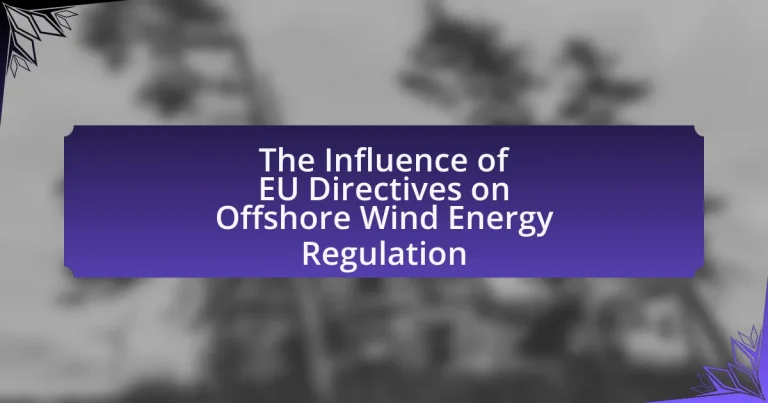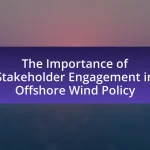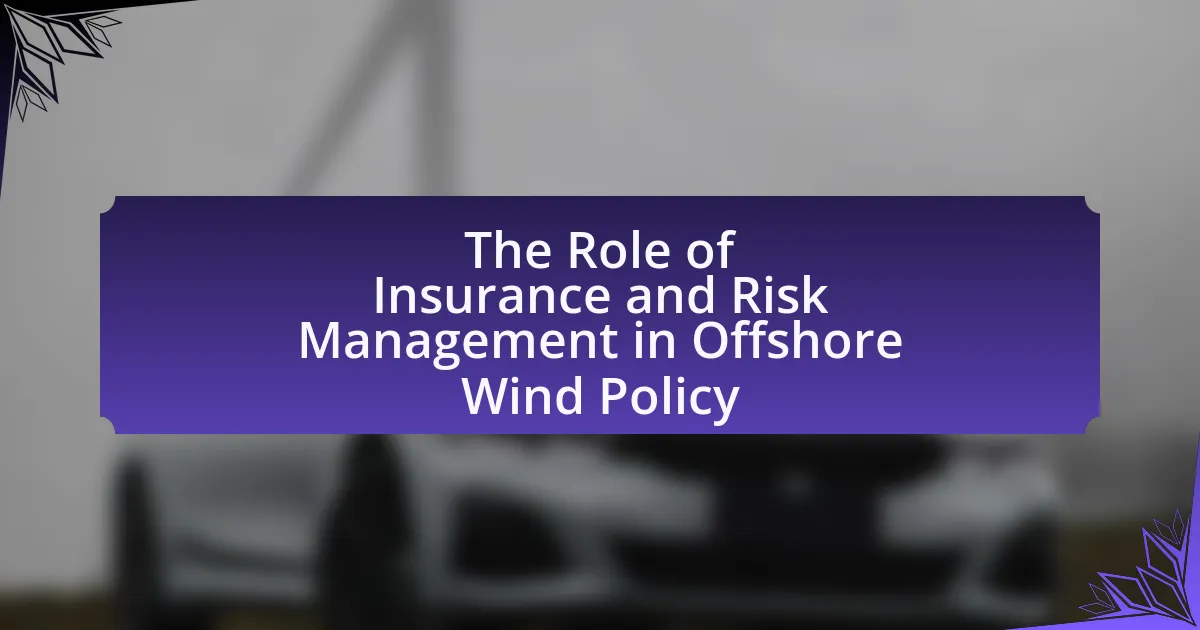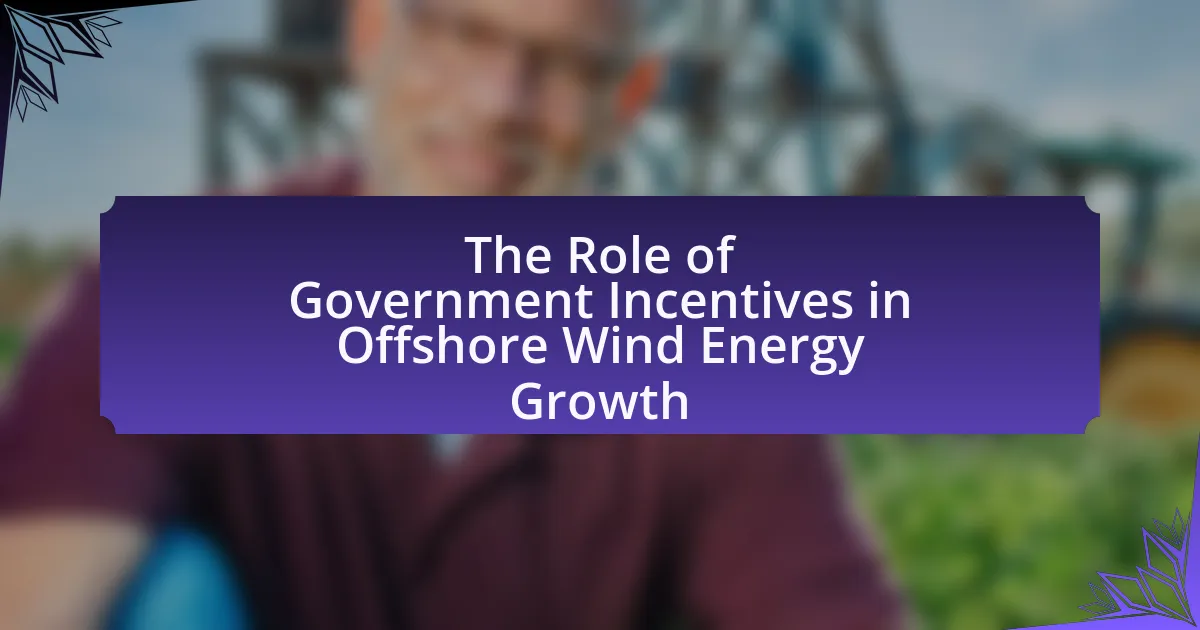EU Directives are essential legal instruments of the European Union that shape the regulatory landscape for offshore wind energy across member states. This article examines the role of key directives, such as the Renewable Energy Directive and the Environmental Impact Assessment Directive, in promoting renewable energy development while ensuring environmental protection. It highlights how these directives influence national regulations, facilitate investment, and create economic benefits, while also addressing challenges such as regulatory complexity and compliance costs. Additionally, the article explores future trends in EU policies and best practices for stakeholders to navigate the evolving regulatory framework effectively.
What are EU Directives and their role in Offshore Wind Energy Regulation?
EU Directives are legal acts of the European Union that require member states to achieve specific results while allowing them the flexibility to choose how to implement these results. In the context of offshore wind energy regulation, EU Directives play a crucial role by establishing a framework for environmental protection, energy efficiency, and renewable energy development. For instance, the Renewable Energy Directive sets binding targets for renewable energy use, which directly influences national policies on offshore wind projects. Additionally, the Environmental Impact Assessment Directive mandates assessments for projects that may significantly affect the environment, ensuring that offshore wind developments comply with environmental standards. These directives collectively guide member states in creating coherent and effective regulations that promote the growth of offshore wind energy while safeguarding ecological integrity.
How do EU Directives influence national regulations on offshore wind energy?
EU Directives significantly shape national regulations on offshore wind energy by establishing a framework that member states must follow, ensuring consistency and promoting renewable energy development. These directives, such as the Renewable Energy Directive and the Offshore Renewable Energy Strategy, set binding targets for renewable energy production and outline environmental and safety standards that national laws must incorporate. For instance, the Renewable Energy Directive mandates that EU countries achieve at least 32% of their energy from renewable sources by 2030, compelling nations to create supportive policies for offshore wind projects. This harmonization facilitates cross-border cooperation and investment, ultimately accelerating the transition to sustainable energy across Europe.
What are the key EU Directives relevant to offshore wind energy?
The key EU Directives relevant to offshore wind energy include the Renewable Energy Directive (RED II), the Marine Spatial Planning Directive, and the Environmental Impact Assessment Directive (EIA). The Renewable Energy Directive sets binding targets for renewable energy use, promoting the development of offshore wind projects across member states. The Marine Spatial Planning Directive facilitates the sustainable use of marine resources, ensuring that offshore wind installations are planned effectively to minimize environmental impacts. The Environmental Impact Assessment Directive mandates assessments for projects likely to have significant effects on the environment, ensuring that offshore wind developments comply with environmental protection standards.
How do these directives promote sustainability in offshore wind energy?
EU directives promote sustainability in offshore wind energy by establishing regulatory frameworks that encourage the development and integration of renewable energy sources. These directives set binding targets for renewable energy production, such as the Renewable Energy Directive, which aims for at least 32% of the EU’s energy to come from renewable sources by 2030. Additionally, they provide guidelines for environmental assessments and stakeholder engagement, ensuring that offshore wind projects minimize ecological impacts and promote social acceptance. The directives also facilitate cross-border cooperation and investment in offshore wind infrastructure, enhancing energy security and reducing greenhouse gas emissions across member states.
What challenges do EU Directives present for offshore wind energy development?
EU Directives present several challenges for offshore wind energy development, primarily related to regulatory complexity and compliance costs. The intricate framework of EU legislation, including directives on environmental protection, maritime spatial planning, and energy efficiency, often leads to lengthy permitting processes that can delay project timelines. For instance, the Habitats Directive requires extensive environmental assessments, which can prolong the approval process and increase costs for developers. Additionally, differing interpretations of EU Directives among member states can create inconsistencies in regulatory requirements, complicating cross-border projects and leading to further delays. These challenges hinder the timely deployment of offshore wind projects, impacting the overall growth of renewable energy in the EU.
How do compliance costs affect offshore wind energy projects?
Compliance costs significantly impact offshore wind energy projects by increasing the overall financial burden on developers. These costs arise from the need to adhere to various regulations and standards set forth by EU directives, which can include environmental assessments, safety protocols, and operational guidelines. For instance, a study by the European Commission indicated that compliance with the EU Renewable Energy Directive can add up to 20% to project costs due to extensive regulatory requirements. This financial strain can deter investment, slow project development, and ultimately affect the competitiveness of offshore wind energy compared to other energy sources.
What are the implications of varying interpretations of EU Directives across member states?
Varying interpretations of EU Directives across member states lead to inconsistencies in regulatory frameworks, which can hinder the development of offshore wind energy projects. For instance, different member states may implement directives related to environmental assessments or energy production standards in ways that create barriers for cross-border investments and project approvals. This fragmentation can result in increased costs and delays for developers, as they must navigate a patchwork of regulations rather than a unified approach. Additionally, the lack of harmonization can undermine the EU’s overall renewable energy goals, as member states may prioritize national interests over collective objectives, ultimately affecting the transition to sustainable energy sources.
How do EU Directives impact the growth of offshore wind energy in Europe?
EU Directives significantly enhance the growth of offshore wind energy in Europe by establishing a regulatory framework that promotes investment, harmonizes standards, and facilitates cross-border cooperation. For instance, the Renewable Energy Directive sets binding targets for renewable energy sources, compelling member states to increase their offshore wind capacity. Additionally, the Offshore Renewable Energy Strategy aims to deploy at least 300 GW of offshore wind by 2050, providing a clear long-term vision that attracts investment. Furthermore, the EU’s commitment to reducing greenhouse gas emissions by at least 55% by 2030 under the European Climate Law creates a favorable environment for renewable energy projects, including offshore wind. These directives collectively drive technological innovation, streamline permitting processes, and encourage public-private partnerships, thereby accelerating the deployment of offshore wind energy across Europe.
What are the economic benefits of EU Directives for offshore wind energy?
EU Directives for offshore wind energy provide significant economic benefits, including increased investment, job creation, and enhanced energy security. These directives create a regulatory framework that attracts private and public investments, leading to an estimated €200 billion investment in offshore wind projects by 2030 across Europe. Furthermore, the sector is projected to create over 200,000 jobs in manufacturing, installation, and maintenance, contributing to local economies. Additionally, by promoting renewable energy sources, EU Directives reduce dependency on fossil fuels, thereby stabilizing energy prices and enhancing energy security for member states.
How do EU Directives facilitate investment in offshore wind projects?
EU Directives facilitate investment in offshore wind projects by establishing a regulatory framework that promotes consistency, transparency, and financial incentives across member states. These directives, such as the Renewable Energy Directive and the Offshore Renewable Energy Strategy, set binding targets for renewable energy production, which encourages national governments to create supportive policies and investment environments. For instance, the European Commission’s commitment to achieving at least 40% of energy from renewable sources by 2030 drives member states to prioritize offshore wind development, leading to increased funding and investment opportunities. Additionally, the directives streamline permitting processes and enhance cross-border cooperation, reducing bureaucratic hurdles and fostering a more attractive investment landscape for private and public stakeholders.
What role do EU Directives play in job creation within the offshore wind sector?
EU Directives significantly contribute to job creation within the offshore wind sector by establishing regulatory frameworks that promote investment and development. These directives, such as the Renewable Energy Directive and the Offshore Renewable Energy Strategy, set binding targets for renewable energy production, which incentivizes companies to invest in offshore wind projects. For instance, the European Commission’s goal of achieving at least 60 gigawatts of offshore wind capacity by 2030 is projected to create hundreds of thousands of jobs across various sectors, including manufacturing, installation, and maintenance. Additionally, EU Directives facilitate cross-border cooperation and funding mechanisms, further enhancing job opportunities in the offshore wind industry.
How do EU Directives address environmental concerns in offshore wind energy?
EU Directives address environmental concerns in offshore wind energy primarily through the Environmental Impact Assessment (EIA) Directive and the Habitats Directive. The EIA Directive mandates that member states assess the potential environmental impacts of offshore wind projects before approval, ensuring that ecological considerations are integrated into the planning process. The Habitats Directive protects natural habitats and species, requiring that offshore wind developments do not adversely affect designated sites. These directives collectively promote sustainable development by enforcing rigorous environmental assessments and safeguarding biodiversity, thereby ensuring that offshore wind energy projects align with EU environmental goals.
What measures are included in EU Directives to protect marine ecosystems?
EU Directives include several measures to protect marine ecosystems, such as the Marine Strategy Framework Directive (MSFD), which aims to achieve Good Environmental Status of the EU’s marine waters by 2020 and to protect the resource base upon which marine-related economic and social activities depend. Additionally, the Habitats Directive and the Birds Directive establish a network of protected areas known as Natura 2000, which safeguards critical habitats and species. These directives require member states to assess the impact of human activities, including offshore wind energy projects, on marine biodiversity and to implement conservation measures accordingly. The directives also promote the sustainable use of marine resources, ensuring that activities do not compromise the health of marine ecosystems.
How do EU Directives ensure compliance with environmental standards?
EU Directives ensure compliance with environmental standards by establishing legally binding requirements that member states must implement into national law. These directives set specific environmental objectives, such as reducing emissions or protecting biodiversity, and provide a framework for monitoring and enforcement. For instance, the EU’s Environmental Impact Assessment Directive mandates that projects likely to have significant environmental effects undergo assessments to evaluate their impact before approval. This process ensures that environmental considerations are integrated into decision-making. Additionally, the European Commission monitors compliance and can initiate infringement procedures against member states that fail to adhere to these directives, thereby reinforcing accountability and adherence to environmental standards.
What are the future trends of EU Directives in offshore wind energy regulation?
Future trends of EU Directives in offshore wind energy regulation include increased harmonization of permitting processes, enhanced environmental protection measures, and a focus on integrating offshore wind into the broader energy system. The European Commission aims to streamline regulations to facilitate faster project approvals, as evidenced by the Offshore Renewable Energy Strategy, which targets a significant increase in offshore wind capacity by 2030. Additionally, upcoming directives are expected to emphasize sustainability, requiring comprehensive environmental assessments and stakeholder engagement to mitigate ecological impacts. These trends reflect the EU’s commitment to achieving climate neutrality by 2050 and enhancing energy security through renewable sources.
How might upcoming EU policies shape offshore wind energy development?
Upcoming EU policies are likely to accelerate offshore wind energy development by establishing stricter renewable energy targets and streamlining regulatory processes. The European Green Deal aims for at least 40% of energy to come from renewable sources by 2030, which necessitates significant investment in offshore wind infrastructure. Additionally, the EU’s Offshore Renewable Energy Strategy outlines plans to increase the installed capacity of offshore wind to 300 GW by 2050, promoting technological innovation and financial support mechanisms. These policies create a favorable environment for investment and development, as they provide clear guidelines and incentives for both public and private stakeholders in the offshore wind sector.
What are the anticipated changes in EU Directives regarding renewable energy targets?
Anticipated changes in EU Directives regarding renewable energy targets include an increase in the overall renewable energy share to at least 40% by 2030, as outlined in the European Green Deal. This shift aims to accelerate the transition to renewable sources, particularly in offshore wind energy, which is expected to play a crucial role in achieving these targets. The European Commission has proposed revisions to the Renewable Energy Directive, emphasizing the need for member states to enhance their national contributions and streamline permitting processes for renewable projects. These changes are supported by the EU’s commitment to climate neutrality by 2050, which necessitates significant investments and policy adjustments in renewable energy sectors.
How can stakeholders prepare for potential regulatory shifts in offshore wind energy?
Stakeholders can prepare for potential regulatory shifts in offshore wind energy by actively engaging in policy discussions and monitoring legislative developments. This proactive approach allows stakeholders to anticipate changes and adapt their strategies accordingly. For instance, the European Union’s Renewable Energy Directive emphasizes the need for member states to increase renewable energy production, which may lead to new regulations affecting offshore wind projects. By staying informed about such directives and participating in consultations, stakeholders can influence policy outcomes and align their operations with emerging regulations.
What best practices can be adopted to navigate EU Directives in offshore wind energy?
To navigate EU Directives in offshore wind energy effectively, stakeholders should adopt a proactive compliance strategy that includes thorough understanding of relevant regulations, stakeholder engagement, and continuous monitoring of legislative changes. A comprehensive understanding of directives such as the Renewable Energy Directive and the Offshore Renewable Energy Strategy is essential, as these documents outline specific requirements and targets for member states. Engaging with local authorities, industry groups, and environmental organizations fosters collaboration and ensures that all perspectives are considered, which can facilitate smoother project approvals. Additionally, implementing a system for tracking legislative updates allows stakeholders to adapt to changes promptly, ensuring ongoing compliance and alignment with EU goals.
How can developers ensure compliance with EU Directives effectively?
Developers can ensure compliance with EU Directives effectively by implementing a structured approach that includes thorough understanding of the relevant directives, regular audits, and stakeholder engagement. Understanding the specific requirements of directives such as the Renewable Energy Directive and the Environmental Impact Assessment Directive is crucial for developers to align their projects with EU regulations. Regular audits help identify compliance gaps and ensure adherence to legal obligations, while engaging stakeholders, including local communities and regulatory bodies, fosters transparency and collaboration, which are essential for successful project implementation. This structured approach is supported by the European Commission’s guidelines on best practices for compliance, which emphasize the importance of proactive measures in regulatory adherence.
What strategies can be employed to engage with policymakers on offshore wind energy issues?
To engage with policymakers on offshore wind energy issues, stakeholders can employ strategies such as direct advocacy, coalition building, and providing data-driven research. Direct advocacy involves meeting with policymakers to discuss the benefits of offshore wind energy, emphasizing its potential for job creation and carbon reduction. Coalition building among industry players, environmental groups, and local communities can amplify the message and demonstrate broad support for offshore wind initiatives. Providing data-driven research, such as studies showing the economic viability and environmental benefits of offshore wind, can influence policymakers by presenting concrete evidence that supports policy changes. For instance, a report by the International Renewable Energy Agency highlights that offshore wind could provide up to 18% of global electricity by 2050, showcasing its potential impact and relevance in policy discussions.




